Iowa is packed with over 1,100 incredible wildlife species thanks to its diverse forests, lakes, rivers, farmland, and prairies. It’s home to the rare black and white bobolink bird that takes advantage of Iowa’s prairie land, but what wildlife lives atop Hawkeye Point, Iowa’s highest point?
In this article, we’ll take a look at the animals that prowl Hawkeye Point and the surrounding areas.
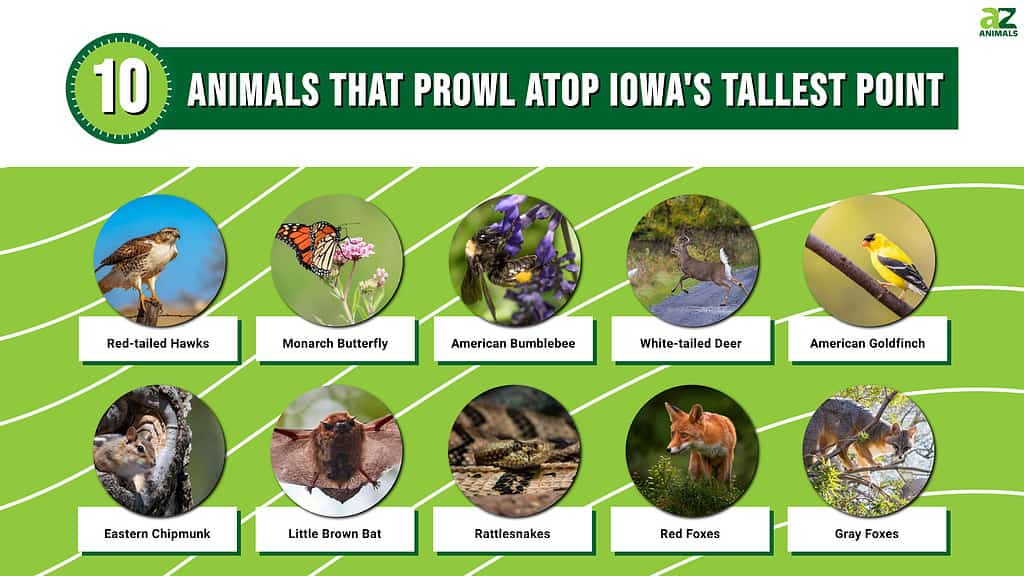
Where Is Iowa’s Highest Point?
Hawkeye Point, Iowa’s highest point, is 1,670 feet tall. Not long ago, it was a vast cornfield, but since 2008, Osceola County has turned it into a park with nearby campgrounds and facilities.
This family-friendly high point is reachable by car. There’s no need to step out and hike it! The drive-up passes silos and old farm buildings, 12 camping sites, picnic tables, a playground, and other amenities such as a shelter and bathhouse.

Iowa’s highest point is Hawkeye Point: it’s a well-maintained tourist attraction accessible by car.
©Evilwop66 / CC BY-SA 3.0, Wikimedia Commons – License
What Animals Live at Hawkeye Point?
The highest point is a well-maintained tourist center without the array of wildlife expected at the peak of a rugged wilderness mountain. However, wildlife lives in and surrounds this vast open space. At the highest point, visitors might see the following animals.
1. Red-Tailed Hawks
Red-tailed hawks are the most common bird of prey in the United States. They patrol skies above open ground near woods, keeping a keen eye out for rodents, snakes, and amphibians. Once targeted, a red-tailed hawk swoops down and pins its victim to the ground with razor-sharp talons.
These magnificent birds reach 28 inches tall with a wingspan of over four feet. Their most recognizable feature is the red tail that fans out when they hover above prey.
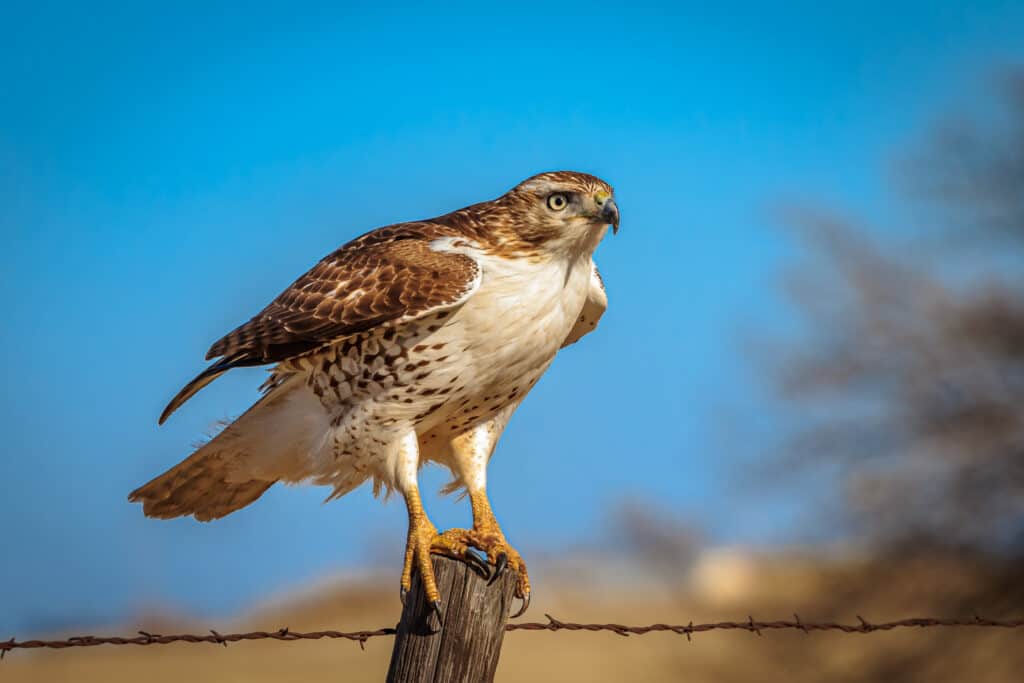
Red-tailed hawks prey on rodents and other small mammals.
©Richard G Smith/Shutterstock.com
2. Monarch Butterfly
Monarch butterflies thrive on the milkweed and wildflowers growing on Hawkeye Point. Painted orange with black veining and white patches, this insect is migratory. Adults migrate thousands of miles, traveling up to 250 miles a day!
Because females lay eggs on milkweed, this butterfly is able to complete its whole lifecycle on Hawkeye Point from egg to larva, pupa, and flying adult. Predatory species include birds, wasps, and mice that eat monarchs at all lifecycle stages.
The plethora of wildflowers and sunshine attracts a host of butterflies to Hawkeye Point. Other butterflies at Hawkeye Point are red admirals, painted ladies, skippers, and Eastern tiger swallowtails.
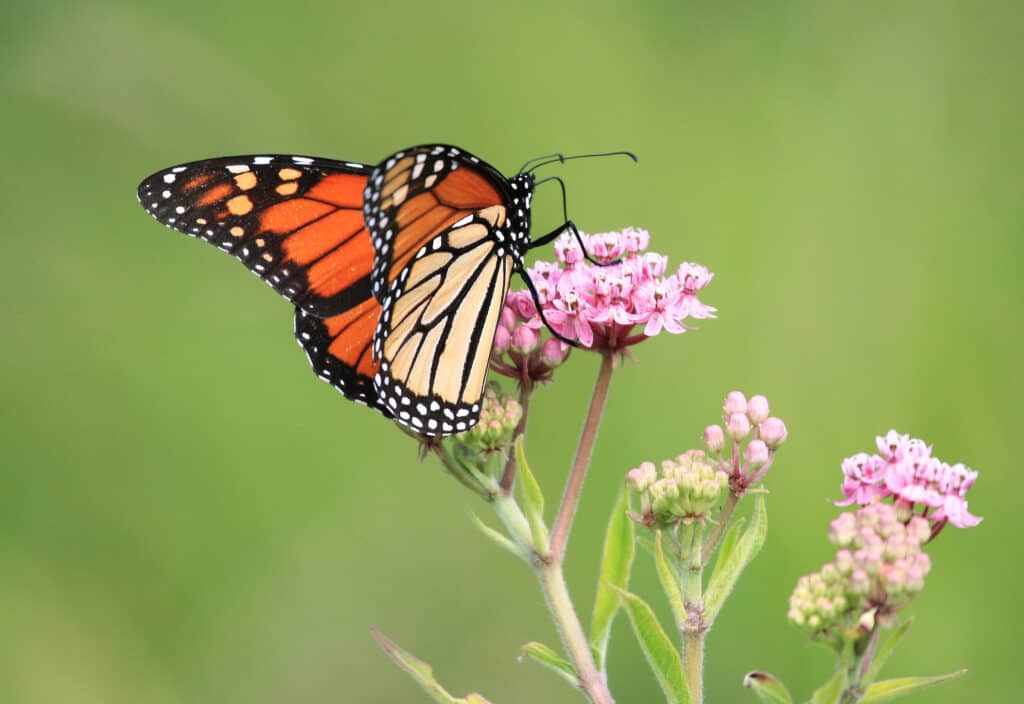
Milkweed is the preferred food and larval habitat for monarch butterflies.
©David Byron Keener/Shutterstock.com
3. American Bumblebee
American bumblebee numbers have declined, but the scientifically named Bombus pensylvanicus is spotted in Iowa feeding on wildflowers. It’s a rare bee, so if you spot it, feel pretty pleased with yourself.
A queen American bumblebee reaches 25 mm and sports chiefly black fur. Workers display a yellow middle band.
Robber flies, birds, and dragonflies predate bumblebees, and many are ambushed by parasitic insects that use the bee’s body to raise its larvae, such as beewolf wasps.
Although the peak of Hawkeye Point isn’t home to a wide variety of animals, its surrounding trails contain many more. Hikers bagging the peak may run across these Iowan animals.

American bumblebee numbers are declining across the U.S. due to habitat loss.
©Stanley Ford/Shutterstock.com
4. White-Tailed Deer
White-tailed deer live in and around woods and forest edges, grazing on greenery from grass to tree buds. If startled, they have tan or reddish brown coats with black noses and raise a bright white tail. A flash of bright white fading into the distance is common on Iowa’s hiking trails.
Male white-tailed deer reach around four feet tall and annually shed their antlers. Hikers may find antlers on trackways and other places white-tailed deer spend time. They’re very popular with children.
Although white-tailed deer are crepuscular and usually most active at dawn and dusk, they’re a frequent spot for quiet woodland hikers throughout the day. Timid of humans, these deer can clock 30 mph and leap 10 feet into the air to escape threats.
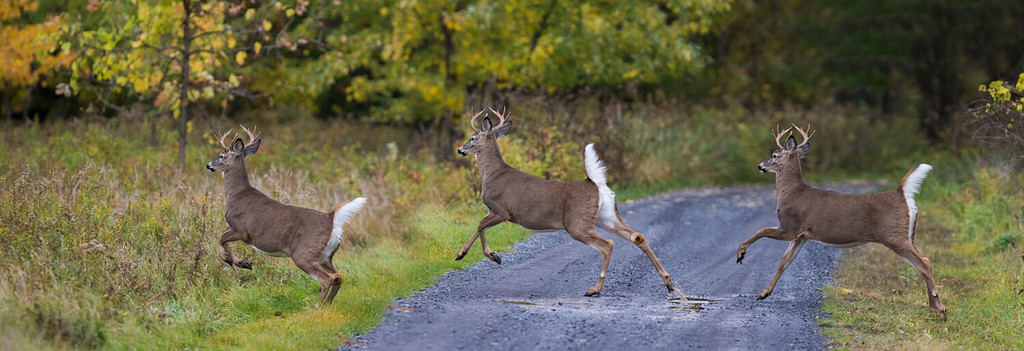
White-tailed deer can run at 30 mph and jump 10 feet high.
©Mircea Costina/Shutterstock.com
5. American Goldfinch
Iowa’s state bird is the American goldfinch. It’s a common bird in Iowa’s Osceola County’s open woods, marshy areas, and suburban gardens. Inquisitive, brave, and bright vivid yellow, this songbird is hard to miss.
It’s a migratory bird that nests in summer and eats a diet of seeds along with occasional insects. Near Hawkeye Point, American goldfinch groups gather on open land rich in seeds, such as open crop fields and woodland edges, to feed in safety and sing their “po-ta-toe-chip” song.
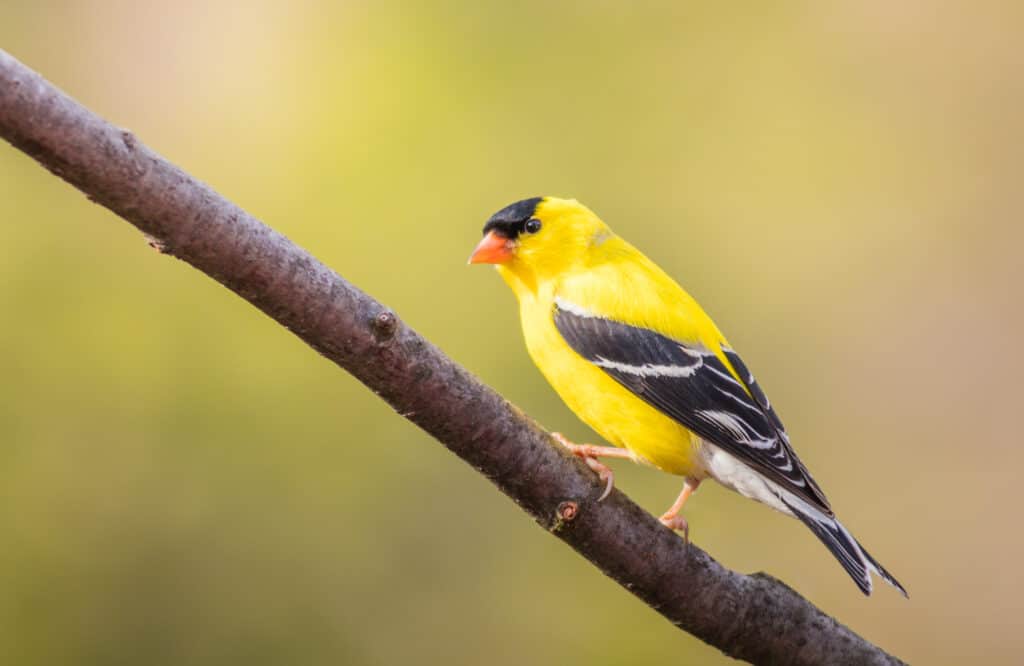
American goldfinches congregate in large groups to chirp their “po-ta-toe-chip” song and eat in safety.
©Rabbitti/Shutterstock.com
6. Eastern Chipmunk
Eastern chipmunks are prevalent throughout Iowa. They’re the largest chipmunk species to inhabit burrows in the woodlands surrounding Hawkeye Point, where there’s plenty of cover from predator hawks and snakes.
An Eastern chipmunk is only around 10 inches long and typically weighs three ounces, but it can run at a speedy 18 mph. Tan in color, these cute little creatures have five black body stripes and four tan-brown face stripes.
Most of their time is spent collecting nuts to cache for winter. A single Eastern chipmunk is capable of collecting 165 acorns in a day. Hikers may spot busy “grinnies,” as the Iowans call them, in the morning and early afternoon.
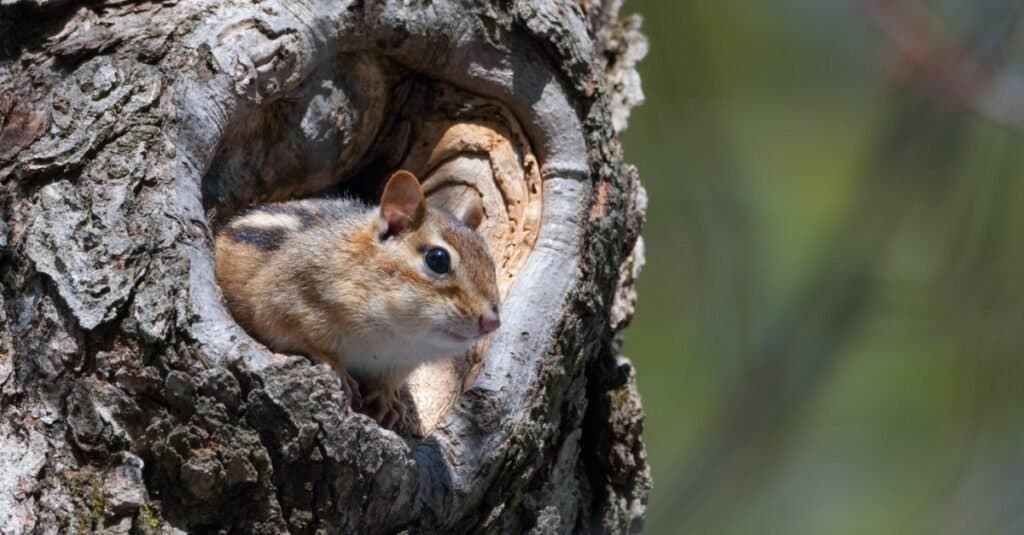
The Eastern Chipmunk is the largest chipmunk in North America.
©iStock.com/Kyle Bedell
7. Little Brown Bat
One of the rarest bat species in the U.S. is the little brown bat, which flits around Iowa’s dusky skies near Hawkeye Point.
Using echolocation to move around their environment, little brown bats hunt down moths and insects on the wing, often swooping over water to capture skimming insects. These small 9-11 inch wingspan cuties are covered in fluffy brown fur, and one can cover a mile each evening swooping down on its numerous meals.
Little brown bats prefer forests, woodland, wetlands, and urban areas. They roost in caves, tree hollows, or buildings in large social groups of approximately 10,000 individuals.

Little brown bats use echolocation to prey on moths and other insects at dusk.
©Bernd Wolter/Shutterstock.com
8. Rattlesnakes
Iowa’s prairies and cornfields provide shelter, prey, and breeding opportunities for 28 snake species, three of which are rattlesnakes. Timber rattlesnakes are the most common, followed by prairie rattlesnakes and the rare Massasauga rattlesnake.
Rattlers are venomous, and bites require medical attention, but they don’t hunt humans. Bites happen if the snake is disturbed or threatened. Their preferred habitat is woodland near rocky slopes, such as the trails around Iowa’s highest point, where they can bask in the sun and prey chiefly on rodents.
Rattlesnakes hibernate using logs, caves, and rock hollows for dens in winter. You can identify a timber rattlesnake by its 36-60 inch gold-brown body with chevron bands.
Prairie and Massasauga rattlesnakes are pretty rare, so they’re not often spotted in Iowa, but timber rattlers turn up regularly. Their large size and toxic venom mean they are dangerous, but they give audible warnings by vibrating their tails and prefer to move away if humans approach quickly.
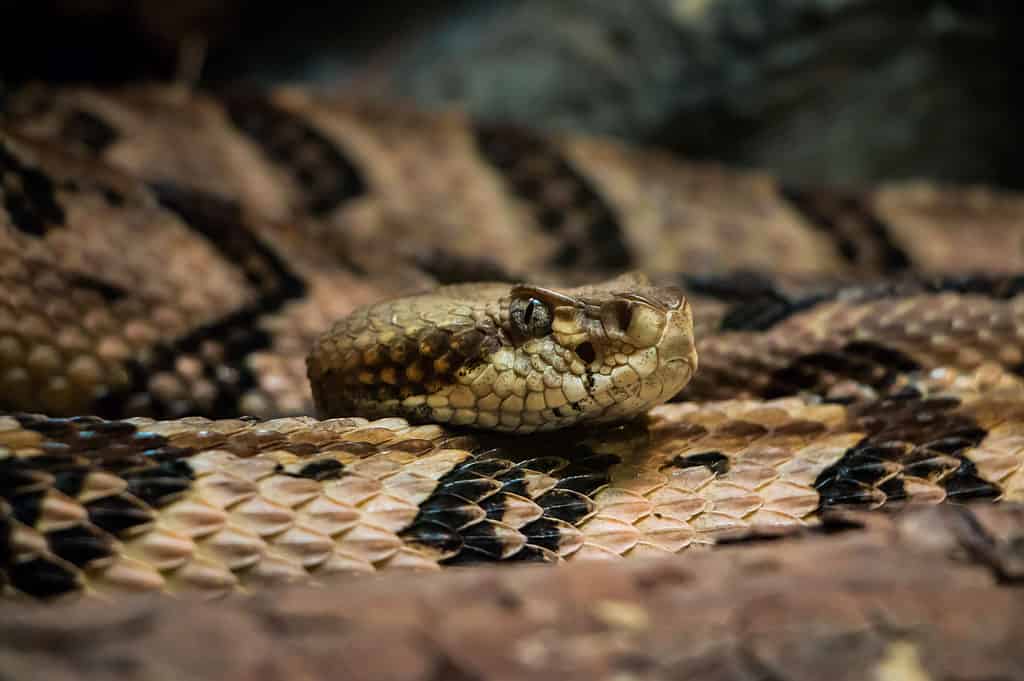
Timber rattlesnakes are the most common rattler in Iowa.
©Dennis Riabchenko/Shutterstock.com
9. Red Foxes
Both red and gray foxes live in the areas surrounding Hawkeye Point, Iowa. These two distinct species don’t mix, but both are wary of humans. Foxes hunt small mammals, birds, amphibians, and even earthworms in forests, grasslands, and urban areas.
Red foxes have reddish-orange coats with white bibs, black legs, and a white-tipped tail, although some black or multi-shaded foxes are actually red fox species, too. Adults weigh anything from 8-15 lbs.
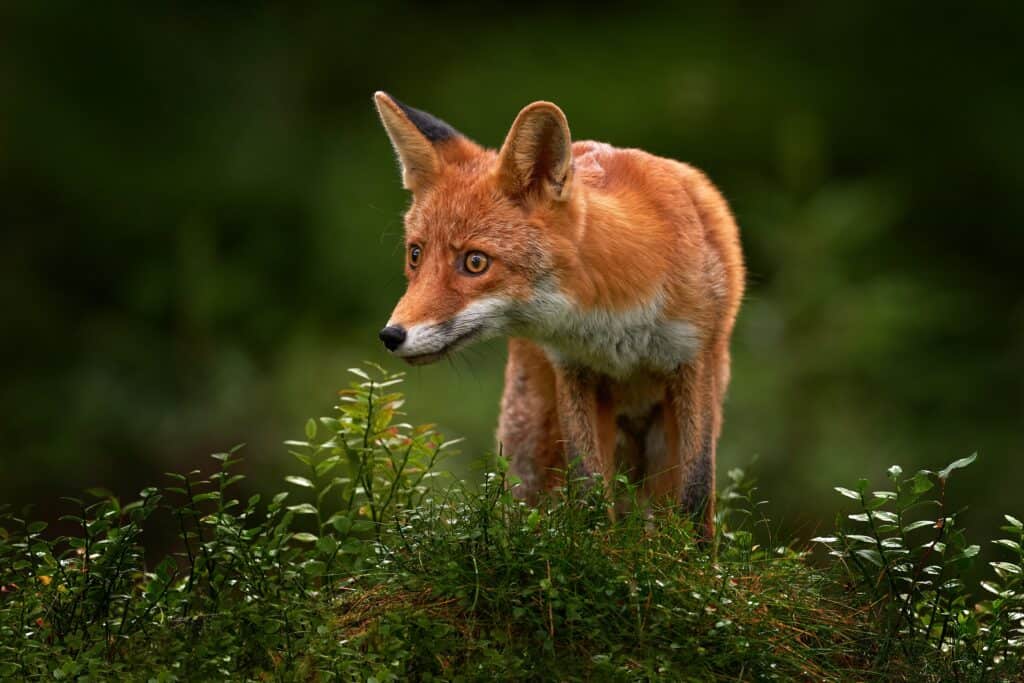
Red foxes have a wide range of vocalizations, including loud, blood-curdling screams.
©Ondrej Prosicky/Shutterstock.com
10. Gray Foxes
Gray foxes have thick gray coats with a white underbelly and a black-tipped tail. They’re smaller than red foxes and more cat-like because their retractable claws allow them to climb trees and hunt among the branches.
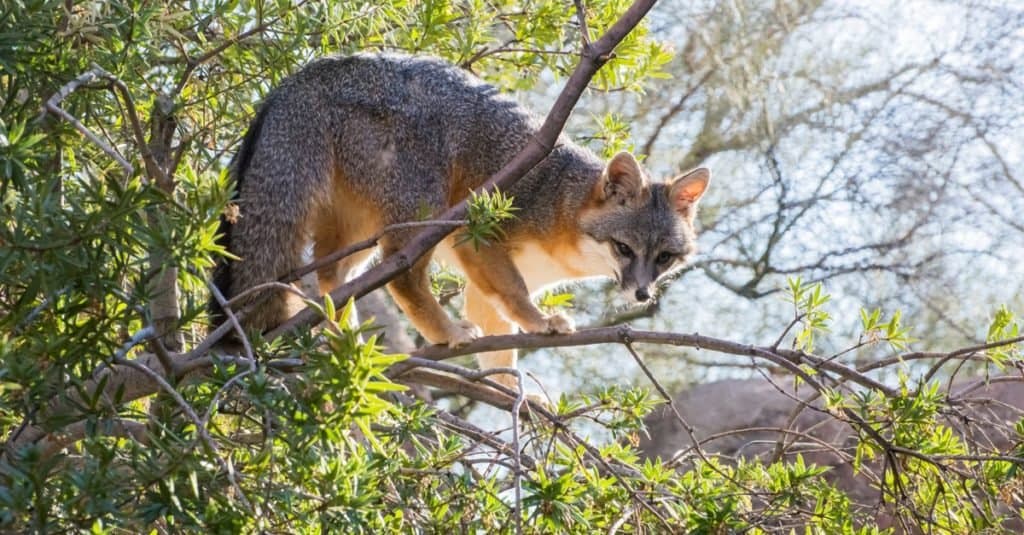
Gray foxes are excellent tree climbers because they have retractable claws like a cat.
©Evelyn D. Harrison/Shutterstock.com
Plants at Hawkeye Point
Because Hawkeye Point in Iowa is a maintained tourist attraction, its summit isn’t a tangled jungle of undergrowth and rare plants.
Instead, visitors encounter a well-manicured play area that’s strewn with wildflowers and grasses. Interpretive signs indicate species and give plenty of information on their growing habits.
Here are a few of the wildflowers and grasses on Hawkeye Point:
- Milkweed
- Black-Eyed Susan
- Aster
- Gentian
- Larkspur
- Prairie rose
- Coneflowers
- Trilliums
- Wild phlox
- Prairie violets
On the lakesides, meadows, bogs, deciduous forests, and prairie trails old willows, reed canary grass, violet wood sorrel, “Dutchman’s breeches”, and white fawn lilies grow. Picking plants here isn’t permitted, so take a photo, admire, and leave the blooms for bees and butterflies.

Wild milkweed grows atop Iowa’s highest point. It attracts butterflies and bumblebees.
©Stacey Welu/Shutterstock.com
Animals at Iowa’s Hawkeye Point
Iowa’s highest point is Hawkeye Point. It’s a well-manicured tourist attraction with a safe road right to the top. This means wild animals tend to keep away, but if you look closely, red-tailed hawks circle above, and incredible insects such as monarch butterflies and bumblebees have made it their home due to the wildflowers that grow there.
Moving down into the surrounding trails widens the breadth of wildlife. Here you might encounter foxes, rattlesnakes, chipmunks, white-tailed deer, American goldfinches, and during the evening, little brown bats.
Animals can occupy even the most industrialized and human-manicured areas. You just need to take a closer look.
Summary of 10 Animals That Prowl Atop Hawkeye Point
| Animal | Fun Fact | |
|---|---|---|
| 1 | Red-tailed Hawks | They are the most common bird of prey in the United States |
| 2 | Monarch Butterfly | Adults migrate up to 250 miles a day |
| 3 | American Bumblebee | Queen bumblebees are all black – workers sport a yellow stripe |
| 4 | White-tailed Deer | Can leap 10 feet into the air |
| 5 | American Goldfinch | These beautiful songbirds congregate in large groups |
| 6 | Eastern Chipmunk | A single busy chipmunk can gather 165 acorns in a day |
| 7 | Little Brown Bat | These insect eaters roost in groups of up to 10,000 |
| 8 | Rattlesnakes | Their venomous bites demand immediate medical attention |
| 9 | Red Foxes | They have a wide range of vocalizations including loud, blood-curdling screams |
| 10 | Gray Foxes | Gray foxes have retractable claws like a cat and can climb trees |
The photo featured at the top of this post is © Gabe Shakour/Shutterstock.com
Thank you for reading! Have some feedback for us? Contact the AZ Animals editorial team.






